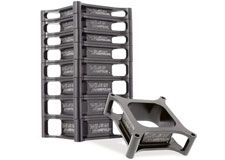
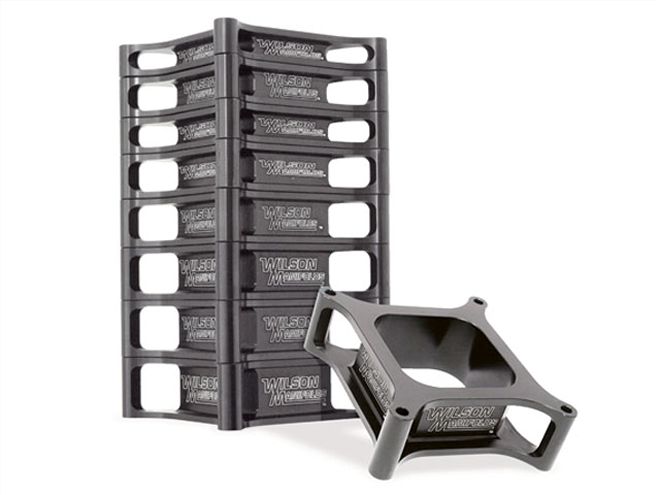
Here's your thought for the day: "After the air and fuel leave the carburetor, if anything happens to that fuel to cause it to fall out of suspension, there are no tricks to getting it back," says intake guru Keith Wilson of Wilson Manifolds. "That fuel will not make power; it's lost energy."
You don't even like to think about how much money you spent getting your carburetor built. The intake runners on the cylinder heads are ported to achieve optimum flow, and the intake manifold has been massaged to match the intake ports, but how much attention was paid to the spacer that ties it all together? Most rule books allow a spacer that's no more than 2 inches tall, but is 2 inches the best size for your engine at your track? Also, what type works best?
Fortunately, there are ways to get a good handle on the size and type of carb spacer that should work best in your application without spending weeks on the dyno. To get that information, we went to Wilson, one of the established experts in the business. For years, Wilson Manifolds has worked with the top teams in Nextel Cup racing. Last year, the company supplied the intakes for Tony Stewart's championship-winning Chevy team, so that's a sign that the organization is on top of its game. In addition, Wilson Manifolds develops spacers for every level of stock car racing you can think of: from two-barrel carburetors, to Quadrajets, to the unlimited dirt Late Model four-barrels. Over 75 different carburetor spacers of every description are offered.
When it comes to circle track racing, there are four main variations on the venerable spacer. In addition to these variations, you can tune with the spacer size. Your rules may limit what is legal, but you still have options when it comes to what size you can run. Unless you are using an intake with an unusually tall plenum, a high-performance race engine will almost always benefit from a spacer of some sort.
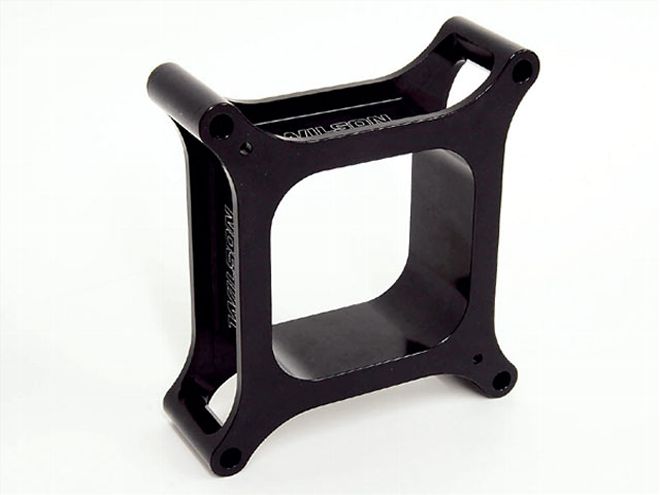 An open spacer is the most basic design. Consider it an easy way to add controlled amounts of plenum volume to the intake to tune the engine's powerband.
An open spacer is the most basic design. Consider it an easy way to add controlled amounts of plenum volume to the intake to tune the engine's powerband.
Consider the open carburetor spacer your baseline. An open spacer is basically an extension of the neck of the intake manifold. Its two main functions are to increase the intake's plenum volume and to increase the distance between the bottom of the carburetor and the roof of the intake manifold runners.
Increasing plenum volume is important because it can be used as an engine tuning tool. "If the motor combination-the cylinder head, manifold, and carburetor-is pretty much in tune," explains Wilson, "the general guideline is that the more plenum volume you have, the more top-end power you are going to make while taking away a little bottom end. Reducing the plenum volume basically does the opposite. It gives the engine more bottom-end torque while taking away some of its ability to make power at the high-rpm range."
Wilson says many teams will use different carb spacers of different heights as a tuning tool-especially on dirt tracks, where the conditions can change dramatically and quickly. If the track conditions are slick, you can add a taller spacer to increase plenum volume. By reducing low-end power it will help keep the car from breaking traction on turn exit, and the increase in high-rpm power will assist the driver from the flag stand through turn entry, where the extra power can be used effectively.
Wilson says that real differences can be felt from the driver's seat with spacer height changes that are as small as fractions of an inch. For that reason, he produces open spacers between 1 and 2 inches in height in 1/8-inch increments to allow racers to tune their engine's powerband to the demands of the track on a particular night.
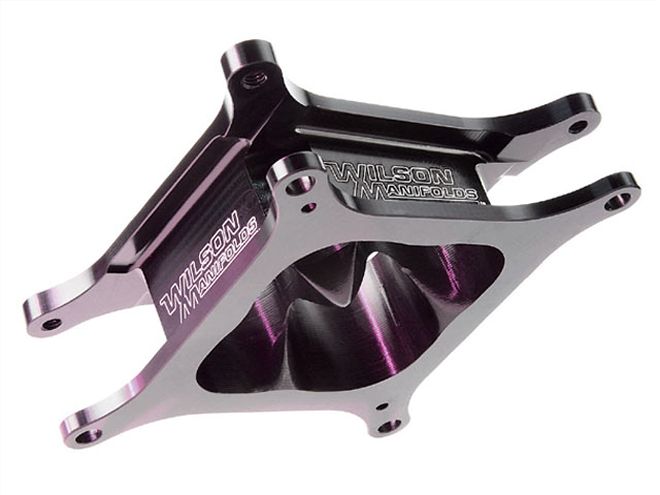 A tapered spacer is the most advanced design.
A tapered spacer is the most advanced design.
Increasing the distance between the bottom of the carburetor and the plenum floor also has advantages-and it works no matter what type of spacer you use. For any carburetor to work at its best, you need a strong vacuum signal from the combustion chambers to create good airflow through the venturis and ensure good mixture quality at the boosters. In a street engine, the distance that you can move the carburetor from the combustion chambers while still getting a strong signal is quite limited. In a more efficient race engine that has more efficient airflow through the ports and runs at a much higher rpm, the signal is typically much stronger and travels a greater distance. This allows you to move the carburetor farther away from the chambers with the use of a carburetor spacer and gives the air/fuel mixture a chance to reduce its velocity before having to make the turn to get into the intake runners. When this turn is too sharp, the fuel (which has a greater mass than the air in which it is suspended) tends to fall out of suspension and collect into larger, unburnable droplets. By using a carburetor spacer to reduce the speed and angle at which the air/fuel charge must make the turn into the runners, you can keep more fuel in suspension all the way to the combustion chambers.
They increase the distance between the carburetor and the intake runner without excessively increasing plenum volume. A four-hole spacer uses holes that are the same diameter or slightly larger than the carburetor's venturis with no taper or angle to the walls. Generally, they help to build low- and mid-range torque and are especially useful on small or slick tracks, where a racer may spend a great portion of the lap at part throttle.
"The throttle blades in the carburetor give so much direction to the air/fuel flow at part throttle, you have to do something to help it out," explains Wilson. "And most racers are at part throttle way more than they would ever believe. I've been to tests at places like Atlanta, Charlotte, and Michigan with Nextel Cup teams-tracks that are real big and people would think are mostly wide open. But the telemetry shows that the drivers spend much of the lap at part throttle, more than even most of them could believe. It's the same situation on smaller or slick tracks.
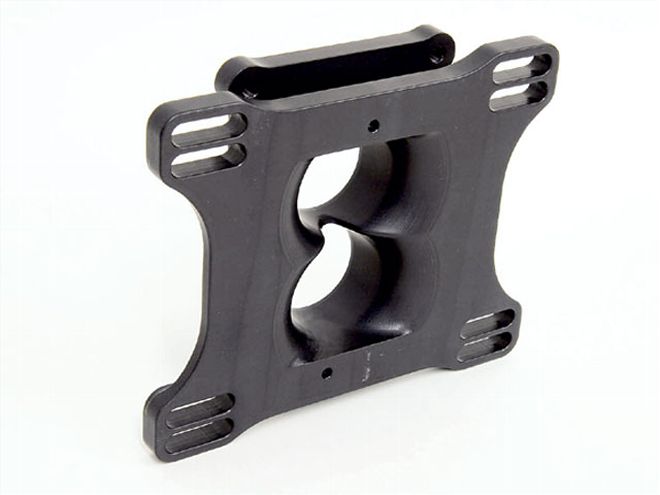 Don't think you are left out if you race in a class that requires two-barrel carbs. Wilson Manifolds has found its tapered designs work well with two-barrel carbs as well, and has produced spacers expressly for them.
Don't think you are left out if you race in a class that requires two-barrel carbs. Wilson Manifolds has found its tapered designs work well with two-barrel carbs as well, and has produced spacers expressly for them.
"If you hold a carburetor and open it to 3/4 throttle, you will see that the blades drive everything to the center of the manifold. So your center four runners-especially on Fords because of the runner layout-get a majority of everything, especially the wet fuel. What happens is they run rich and the outside cylinders go lean.
"To make a motor accelerate best, you want to start where all eight cylinders get the same mix. When you are pulling some cylinders rich and some lean, the motor won't accelerate as quickly as if all eight are the same. So a four-hole helps with that. It straightens out the air/fuel flow at part throttle and sends it straight down out of all four holes, or two if you are running a two-barrel."
The disadvantage of a four-hole spacer, however, is that the exit of the holes can potentially cause a separation of the air/fuel mixture. Because the exit of the hole in the spacer is so close to the roof line of the runners, the turn must be sharper than an open spacer of the same height. A softened edge can help reduce the separation, but the rules often don't allow it.
"When the air/fuel mixture comes off that sharp edge at the exit of the hole, that's where the mixture is forced to turn hard to get into the runners and the fuel separates from the air," Wilson says. "You spend your whole life trying to get the fuel and air mixed on any engine into vapor form. You can buy a $1,000 carburetor that mixes the air and fuel perfectly, but then when you turn it off that sharp edge at the bottom of the spacer it goes wet again. And once it goes wet, there is no getting it back.
Finally, Wilson Manifolds offers this tip: If you are racing in a class that requires a 390 carb, which is typically a choke point for the engine, you can actually pick up airflow by using a four-hole spacer with the holes slightly larger than the carburetor venturis. By doing this, you are creating a low-pressure area just underneath the carburetor that helps pull additional air through the venturis. If tapered spacers aren't allowed, this may be a worthwhile option.
A tapered spacer is really a four-hole spacer with softened exit edges taken to an extreme. It begins as a four-hole spacer, but the holes open up in carefully engineered variable radii until it is essentially an open spacer at the base. The way the holes open up creates four venturis that can significantly increase any carburetor's maximum airflow. The result is better air/fuel distribution and more horsepower than just about any other spacer of equivalent height. Wilson Manifolds claims it has seen improvements in terms of airflow through the carburetor by as much as 110 cfm in its tests with the addition of a tapered spacer.
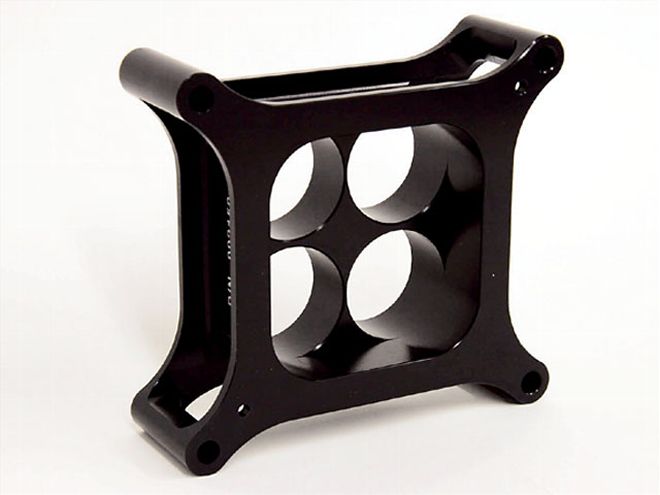 A combo spacer should be used when a tapered spacer causes reversion in your engine.
A combo spacer should be used when a tapered spacer causes reversion in your engine.
"The tapered spacer also improves performance at part throttle," Wilson says. "Everybody dynos at full throttle, and too few pay attention to what's going on at part throttle. It does help pick up airflow at full throttle, but a tapered spacer-seeing as it starts as a four-hole spacer-also helps with the throttle blades directing the air/fuel mixture at part throttle. The spacer also opens up into an open spacer, so it gives the air and fuel time to slow down and make the turn into the runners without separating.
"If there is a disadvantage with a tapered spacer," he continues, "it is if you are getting reversion. Nowadays, with cylinder heads and camming being so much better than they used to be, reversion is rarely a problem. But if you have an engine with a lot of overlap and you have reversion, a four-hole spacer actually funnels that back up the carburetor, which will hurt you. In this situation, you want to use a combo spacer. But that's the only time a tapered spacer won't run better than anything else."
Wilson says a combo spacer is essentially a compromise. A combo spacer is created for situations in which a tapered spacer isn't allowed. It is essentially half of a four-hole spacer mated to half of an open spacer. Unlike a tapered spacer, there is basically no transition between the two. The four-hole half serves to help straighten out the direction of the air/fuel flow coming off the throttle blades at part throttle, while the open half gives the air/fuel stream a little more room and space to make the turn into the runners. What's the advantage of a combo spacer? Wilson says if you are currently running a tapered spacer and notice your engine is suffering from power-robbing reversion, a combo spacer can help eliminate it without an expensive cam change.
If your rule book says nothing about what type of spacer you can use, consider yourself lucky because all the options are open to you. Even if you are limited to one or two types, understanding how spacers affect an engine's performance will help you choose what size you need and can help you get the tuning advantage you seek.
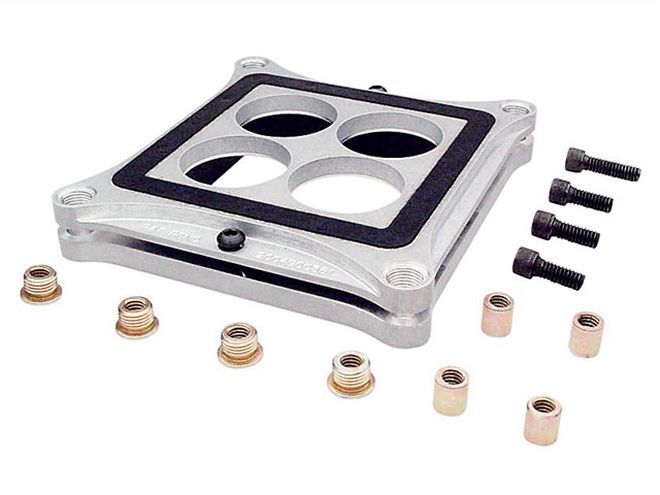 Comp Cams' new vibration absorption spacer is one of the most unique spacer designs to come along in years.
Comp Cams' new vibration absorption spacer is one of the most unique spacer designs to come along in years.
Carburetor spacers constructed from phenolic material to shield the carburetor from heat have been around for years, but Comp Cams recently introduced one of the most unique spacers designed to protect the carb we've ever seen.
Known simply as the vibration absorber carburetor spacer, this piece uses billet aluminum sandwiched around a shock-resistant composite material to shield the carb from the engine's vibrations and heat. Comp claims it prevents upper-level rpm lean out and irregular fuel atomization by preventing the harmful harmonics produced by the engine from making its way to the carb. It is available for 4150-, 4500-, and 2300-style carbs in alcohol and gas versions. For more information on this unique piece, contact Comp Cams at 800/999-0853 or www.compcams.com.